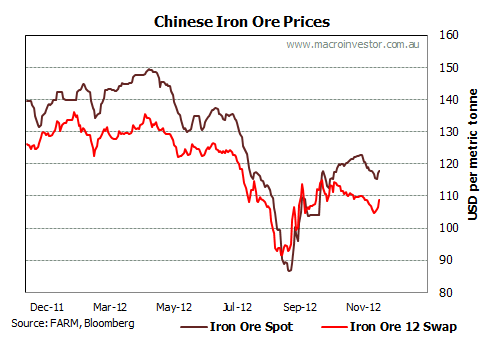
Find above the iron ore price complex table for December 5, 2012. As you can see, for yesterday at least, the gap between swap and spot was closed in favour of the latter:

So, is the correction over?
I don’t think so. And neither does ANZ, which released its monthy forecasts for the commodity complex late yesterday and despite turning bullish across the board issued a conspicuous “sell” for iron ore:
We’ve recently returned from a marketing trip to China and the mood seemed one of caution short term but growing confidence for 2013. The political changeover appeared to have been a big distraction for 2012, and many seemed relieved that the process was passing. The consensus view was that the new government would likely implement a stable growth footing but that an aggressive stimulus push was unlikely. As a result, many thought the outside view on China was too optimistic and that a growth level of around 7% rather than 8% was more realistic going forward.
Despite improving headline numbers, the clients we spoke to felt the current market conditions were still very challenging. Tight liquidity was a problem for many steel and iron ore traders who were resorting to selling stockpiles at cost or even at a loss to raise cash. Banks, who normally reduce lending activity at this time of the year, were especially cautious of commodity traders which had experienced quite volatile market conditions (including force majeure shipments) over the past 3-6 months. One trader told us that it had been the quietest November he could remember and that making money in China had become a lot more difficult than it used to be.
On inventories, total steel mill stockpiles were at a lower than expected 11 million tonnes, down from about 12-13 million tonnes earlier in the year. We found this strange because of the high level of steel production and falling prices through the middle of the year – implying excess supply and rising inventory builds. This partly confirmed that the falling rebar market had been heavily influenced by speculative activity and not necessarily associated with fundamentals over this period – and possibly that stronger seasonal demand had soaked up excess supply.
The sharp swing in iron ore prices in August/September looks inventory-led, with substantial consumer destocking and restocking activity occurring. Steel mill yard iron ore stocks had fallen to a low 10-15 days by end of August but were now back to around 25 days of supply (mills normally operating at around 30 days).
Sticky high domestic iron ore production was partly a function of captive supply and government owned capacity kept open at a loss (a bit like in steel to sustain social stability through the key leadership changeover). Operating costs may have been overestimated with feedback suggesting a high cost floor closer to USD110/t rather than USD120/t. And official data could be missing a good proportion of high cost Hebei iron ore output (which goes unreported) where capacity is still very sensitive to prices under USD120/t.
In coal, stockpiles are high. Late import arrivals from delayed shipments in the third quarter had swollen power plant stockyards meaning winter restocking wouldn’t be substantial. The National Development and Reform Commission’s (NDRC’s) decision to lift annual capped coal prices was seen as a sign that domestic supply conditions had improved.
Steel demand conditions are, not surprisingly, weak. The construction, manufacturing and shipbuilding sectors are most under pressure. Steel demand will grow by a smaller-than-expected 3-4% in 2013 and most of that because 20 million tonnes of new capacity is being commissioned. Construction demand will remain challenging, but improving auto and manufacturing output will prop up activity. The new government will keep a lid on property speculation suggesting real estate activity would be skewed to the public housing programs.
Steel mill margins are again in paper-thin territory – somewhere between break-even to 1%. The sharp rebound in iron ore prices hasn’t been matched by similar gains in steel. The unconsolidated nature of the steel industry doesn’t help, with the top 10 producers only commanding 10% of domestic market share, making it difficult to pass on higher raw material prices. The high level of state-owned enterprise (SOE) supply (75% of total steel output) is also more inelastic to demand meaning most will run, even in a loss-making market.
There doesn’t appear to be as much concern about the high level of Chinese steel capacity. Total steel capacity sits supposedly around 900 million tonnes for a 720 million tonne production level implying a utilisation rate of 80% – an acceptable level for western world producers. Interestingly, it is believed many steel mills over-inflate their capacity potential (counting out-dated or closed facilities) in the aid of achieving a more streamlined approval process for new capacity – brownfield expansions (existing assets) being a lot easier to approve than Greenfield ones (completely new).
The topic of overcapacity generally in China is an interesting one. One client talked of China’s addiction to industrial growth over the past 20 years purely for growth’s sake – regardless of market demand. China’s provincial leadership performances have been very much measured on GDP, which has created a race to expand industrial output. The view was the new government is keen (and would need) to address this inefficiency, but that heavy industry consolidation was probably still a long rather than short term goal. One idea touted was for heavy industry to be centralised back to Beijing.
So, $110 is the new price floor? Sure, for now. Full report below:

